Cooperative research achieves spawning, studies grow-out
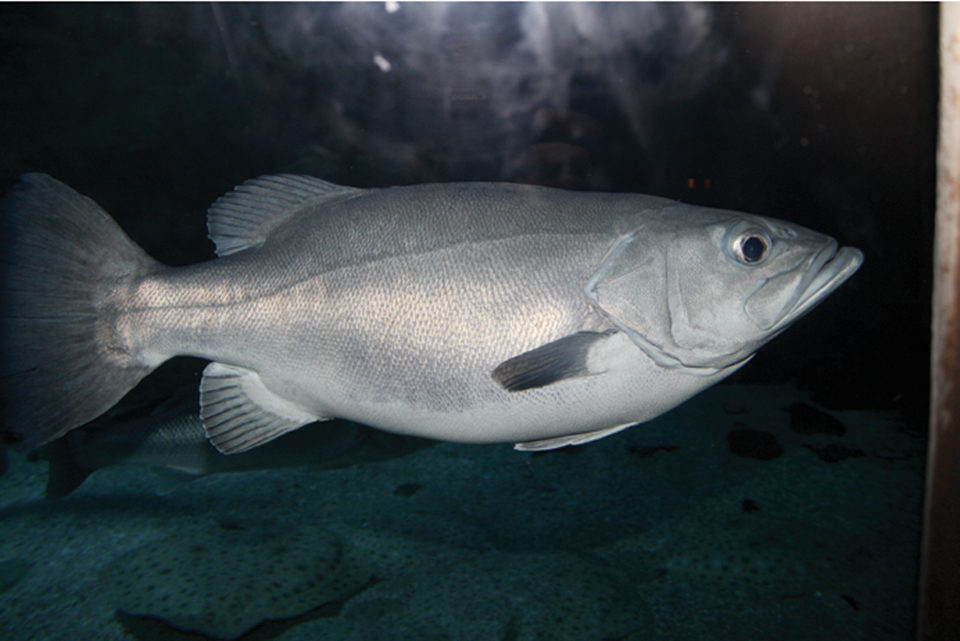
The wreckfish (Polyprion americanus) is a large, demersal teleost fish. It inhabits an area that spans from the littoral region to a depth of 1,000 meters, mainly over rocky blocks at depths from 100 to 200 meters. Young individuals are distributed on the surface, schooling below floating objects, while adult individuals swim alone in deeper waters.
This species’ broad geographic distribution covers the Mediterranean Sea, the Indian Ocean, the southwest and southeast South Pacific, and the east and west coasts of the Atlantic Ocean. Although there is a vast amount of information available on wreckfish fisheries, little has been published on the culture of this species.
Its culture is one of the most interesting options among the new species considered for commercial aquaculture due to its fast growth and attractive market prices. With a shortage of wild individuals, wreckfish feature gene homogeneity of existing stocks, are easily manipulated, have a long juvenile growth phase and exhibit a high growth index during the pelagic life phase.
Culture attempts
The first successful experiments on wreckfish reproduction carried out in Europe took place at the Institute of Aquaculture Hellenic Centre for Marine Research in Crete, Greece. Breeding stock caught in the natural environment were kept at a temperature of 15 degrees C under dim light on a natural photoperiod.
After eight years of conditioning in captivity, spawning was induced using gonadotropin-releasing hormone analog implants. Maturing and spawning were successful, but no viable eggs were obtained. Nevertheless, natural reproduction and spontaneous spawning by the individuals from the GnRHa-induced stock took place in the subsequent year.
Since 2009, the Spanish institutions Instituto Español de Oceanografía (IEO) of Vigo, Spain, and the Instituto Galego de Formación en Acuicultura (IGaFA) in Illa de Arousa, Spain, have cooperated on the development of the culture of this species. Studies carried out so far were focused on the reproductive characteristics and grow-out of wreckfish.
Reproduction
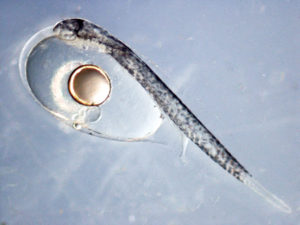
The institutes have an ongoing partnership with Aquarium Finisterrae of A Coruña, Spain, where a stock of 24 wreckfish is kept together with other species in a 4,000-cubic-meter display tank with room-temperature water between 10 and 21 degrees-C under a controlled photoperiod of 12 hours of light. Wreckfish are individually tagged with microchips. Only 16 individuals have been sexually differentiated: 10 females and 6 males.
In May 2011, some females showed abdominal dilation associated with advanced maturity. Two individuals with weights of 25.75 and 25.80 kg and lengths of 92 and 94 cm, respectively, were selected, as well as two males (17.75 and 24.60 kg, and 88 and 97 cm, respectively). To avoid stress during fish manipulation, they were anesthetized.
Oocytes and sperm were obtained by abdominal pressure and kept separately until the artificial fertilization was carried out. Once the oocytes and sperm were combined, seawater was added, and two hours later, fertilization success was verified. Approximately 14,000 fertilized eggs were obtained.
The perfectly spherical eggs showed a slightly striated yolk, which may have indicated low oocyte quality. The fertilization rate for this spawn was 84.0 percent, and the hatching rate was 5.8 percent. This low hatching rate confirmed the poor quality of the eggs.
The eggs were moved to 120-L incubators with recirculating water at a temperature of 16 degrees-C. To identify the different stages of embryonic development, monitoring was carried out every six hours during the first 24 hours, and every 12 hours during the following days.
Eggs hatched seven days later, with larvae 3.8 ± 0.3 mm long at birth. The larvae were kept in the incubator until the yolk sacs were consumed six days later, when they started to die. These results were similar to those obtained at the Institute of Aquaculture Hellenic Center for Marine Research with spawning obtained through hormonal induction.
Growout
Growout experiments were conducted at IGaFA and IEO. Twelve individuals with an initial average weight of 1.21 ± 0.16 kg and 10 individuals with an initial average weight of 7.05 ± 1.22 kg were kept in tanks in each of the centers. Wild wreckfish were captured on the Galician coasts and kept during the quarantine and adaptation phases in the O Grove Aquarium facilities.
At IGaFA, individuals of lot 1 were kept in a 40-cubic-meter rectangular tank throughout the experiment, and the IEO fish (lot 2) were held in a 120-cubic-meter tank. Lot 1 was initially fed semi-moist feed, followed a few days later by dry, 22-mm extruded turbot feed. The wreckfish were fed five days a week until sated.
Lot 2 was fed throughout the experiment with semi-moist feed made of fish, mussels, squid flour and oil. These fish were fed three days a week until sated. Lot 1 individuals were sampled monthly for size and weight. Lot 2 fish were first sampled five months after they were placed in the tank. In this first sampling, individuals were tagged with microchips to allow their identification. After that, sampling was carried out every two months.
At the end of the 753-day experiment, lot 1 fish reached a weight of 7.12 ± 0.77 kg (Fig. 1). These results were slightly better than those obtained in 2004 at the Institute of Aquaculture Hellenic Center for Marine Research. After 465 days, the average weight for the fish in lot 2 was 10.75 ± 1.95 kg (Fig. 2).
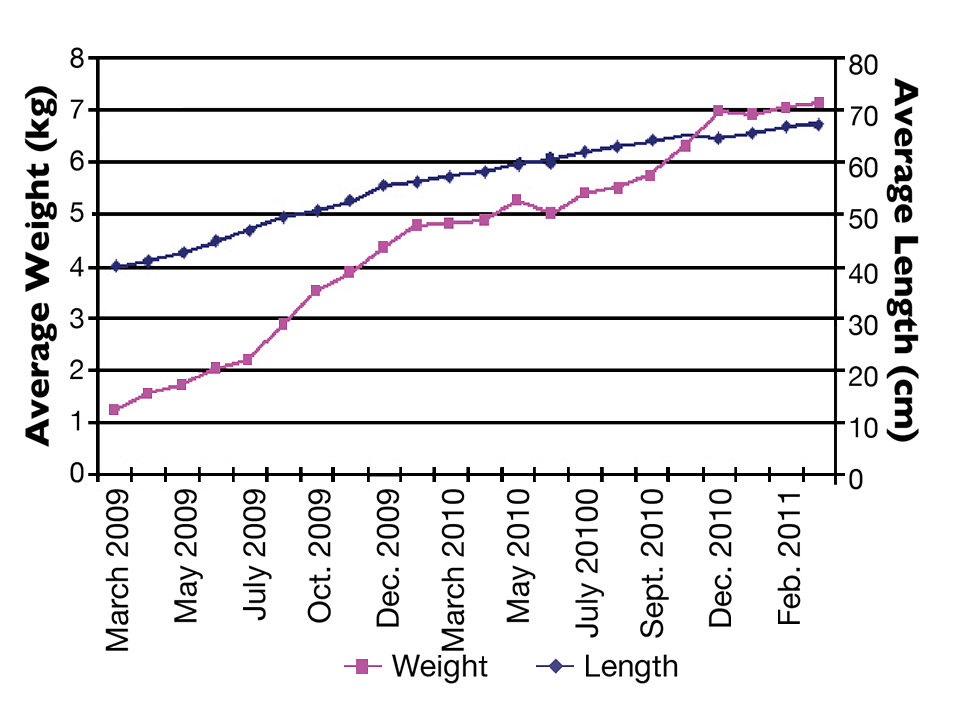
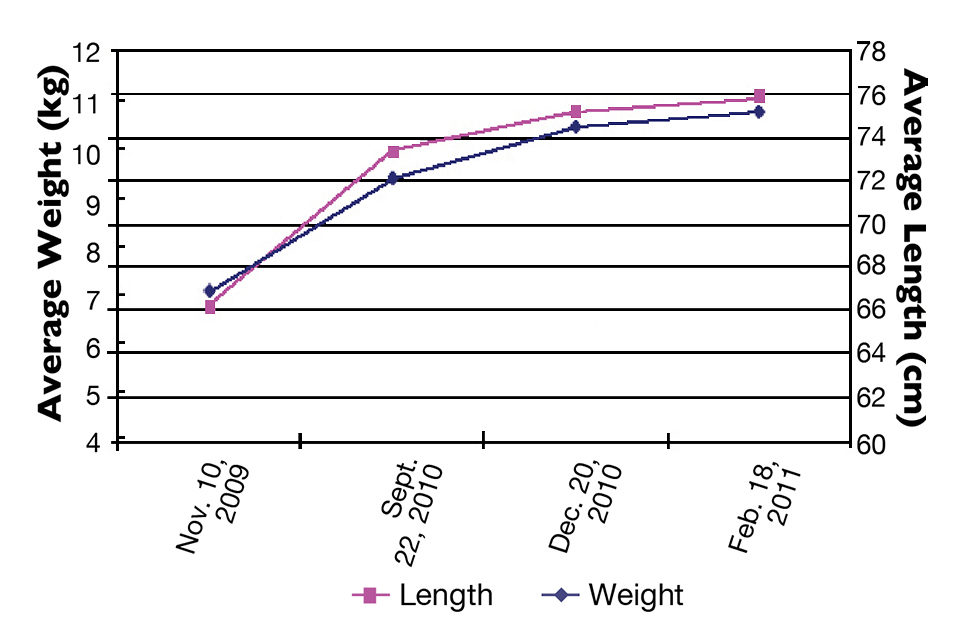
It is important to highlight the growth slowdown – possibly due to reproduction-related processes – that took place from December to February in both groups. A growth slowdown was also observed in lot 1 during the months in which the temperature was above 15 degrees-C. No mortalities or pathological problems were detected in either of the experiments.
Perspectives
Growth and adaptation results for wreckfish in captivity are very encouraging in terms of culturing viability. Nevertheless, in order to develop the culture of this species on an industrial scale, it is essential to deploy further research related to reproduction, larval culture and nutrition.
The clear interest in wreckfish culture expressed by the private sector in several countries makes it important for the different research centers currently working on wreckfish to join their efforts. Exchanging information on the results obtained so far, as well as the difficulties encountered, can contribute to faster progress on different aspects of this species’ culture.]
(Editor’s Note: This article was originally published in the May/June 2012 print edition of the Global Aquaculture Advocate.)
Authors
-
Dr. J.B. Peleteiro
Instituto Español de Oceanografía
Centro Oceanográfico de Vigo
Vigo, Spain[115,101,46,111,101,105,46,105,118,64,111,114,105,101,116,101,108,101,112,46,111,116,105,116]
-
D. J. L. Rodríguez
Instituto Galego de Formación en Acuicultura
Niño do Corvo s/n 36626
Illa de Arousa, Pontevedra, Spain[115,101,46,97,116,110,117,120,64,97,118,101,117,110,97,108,108,105,118,46,122,101,117,103,105,114,100,111,114,46,115,105,117,108,46,101,115,111,120]
Tagged With
Related Posts

Responsibility
A look at integrated multi-trophic aquaculture
In integrated multi-trophic aquaculture, farmers combine the cultivation of fed species such as finfish or shrimp with extractive seaweeds, aquatic plants and shellfish and other invertebrates that recapture organic and inorganic particulate nutrients for their growth.

Aquafeeds
A look at phospholipids in aquafeeds
Phospholipids are the major constituents of cell membranes and are vital to the normal function of every cell and organ. The inclusion of phospholipids in aquafeeds ensures increased growth, better survival and stress resistance, and prevention of skeletal deformities of larval and juvenile stages of fish and shellfish species.
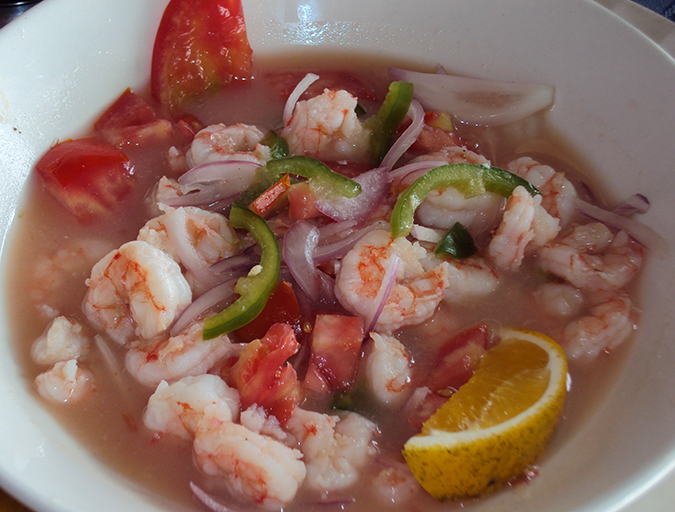
Intelligence
Facts about shrimp and cholesterol
Many people, including health-conscious consumers, are concerned about the cholesterol content of foods such as meat, eggs and dairy products. In the case of shrimp, the cholesterol story is different because a number of research studies have demonstrated that the high percentage of “good fats” in shrimp reduce the impact of cholesterol, and that a majority of people can eat shrimp as part of a balanced diet.
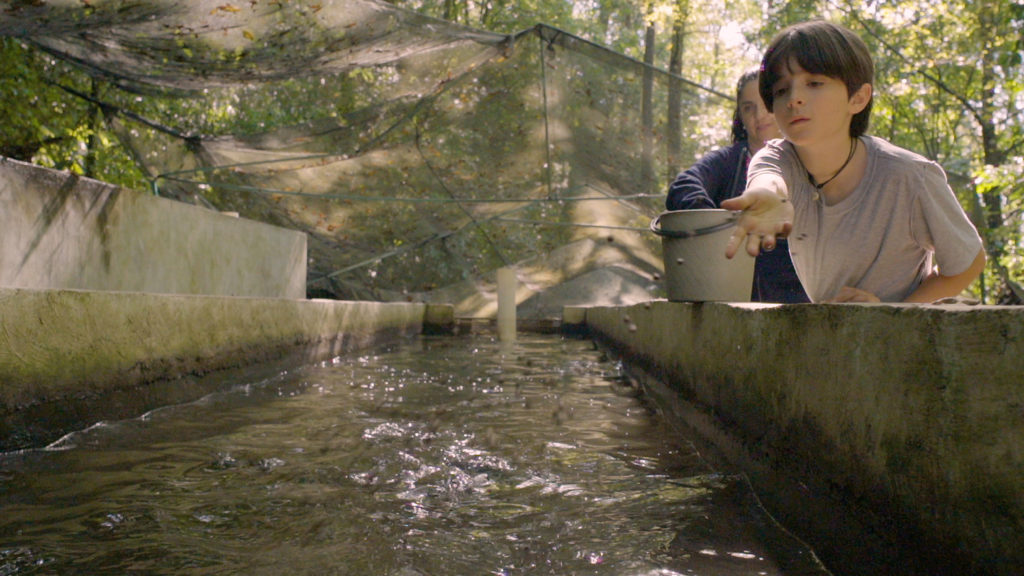
Intelligence
A motive, and a market, for farmed fish in Mexico
Boasting ample areas for aquaculture and a robust domestic demand for seafood – not to mention its close proximity to the U.S. market – a land of opportunity lies in Mexico. Fish farming is primed to meet its potential south of the border.


